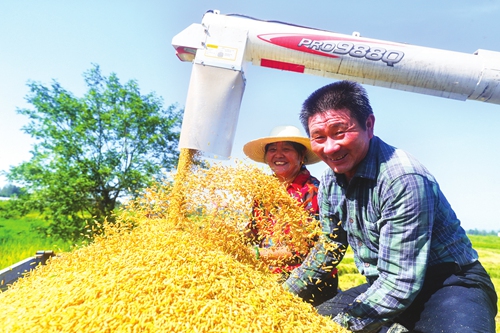
Farmers harvest ratoon crops - those that grow new shoots or sprout from the base of a crop plant - in rice fields in Guangshan county, Central China's Henan Province on Sunday. The county has built 27 rice ratooning bases that allow for double harvests in one growing season. The ratoon crops yield additional revenue of over 600 yuan ($86.33) on average per mu. Photo: cnsphoto
China's total grain stocks remain at a high level, and the stock-to-consumption ratio is much higher than the minimum safety level recommended by the Food and Agriculture Organization of the United Nations, an official from the National Food Strategic Reserves Administration said.
Reserve stocks of rice and wheat can meet demand for more than one year, the official said in an interview with the Xinhua News Agency on Monday.
Recently, some foreign media have fabricated stories with attention-grabbing headlines about China's food supply, claiming that China is suffering a severe food shortage.
Since the outbreak of COVID-19, China's grain and material storage system has been strengthening its organization and scheduling of grain sources, effectively ensuring market stability.
Wheat, rice and other rations account for about 70 percent of the reserve varieties, while some provinces have established a small amount of miscellaneous grain reserves based on their local consumption habits.
Some 36 large and medium-sized cities and regions with volatile markets have established certain reserves such as rice and flour, which can meet local market supply for 10-15 days, the official said.
China has established a system that can respond effectively to the risks caused by potential emergencies and natural disasters.
There are 5,388 State-owned grain emergency processing enterprises with a daily processing capacity of over 1 million tons of finished grain. More than 44,600 grain emergency supply venues, 3,170 emergency distribution centers, and 3,454 emergency storage and transportation enterprises have been established, and are capable of promptly supplying food to the end consumer market.

